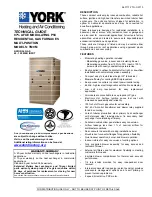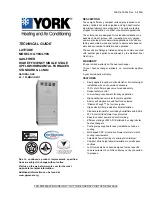
NOTE:
Read the entire instruction manual before performing any
service or maintenance.
This symbol
→
indicates a change since the last issue.
These procedures are for size 60,000 through 117,000 Btuh units.
Index
Page
SAFETY CONSIDERATIONS .....................................................1
ELECTROSTATIC DISCHARGE (ESD) PRECAUTIONS
PROCEDURE ...........................................................................2
CARE AND MAINTENANCE..................................................2-5
Air Filter Arrangement..........................................................2-3
Blower Motor and Wheel .........................................................3
Cleaning Heat Exchanger......................................................4-5
Electrical Controls and Wiring.................................................5
Troubleshooting ........................................................................5
Application Wiring Diagrams ..................................................6
Furnace Wiring Diagram ..........................................................7
Service Label ............................................................................8
Troubleshooting Guide .............................................................9
SAFETY CONSIDERATIONS
Installing and servicing heating equipment can be hazardous due to
gas and electrical components. Only trained and qualified person-
nel should install, repair, or service heating equipment.
Untrained personnel can perform basic maintenance functions
such as cleaning and replacing air filters. All other operations must
be performed by trained service personnel. When working on
heating equipment, observe precautions in the literature, tags, and
labels attached to or shipped with the unit and other safety
precautions that may apply.
In the United States, follow all safety codes including the National
Fuel Gas Code (NFGC) NFPA 54-1996/ANSI Z223.1-1996. In
Canada, refer to CAN/CGA-B149.1- and .2-M95 National Stan-
dard of Canada, Natural Gas and Propane Installation Codes
(NSCNGPIC). Wear safety glasses and work gloves. Have fire
extinguisher available during start-up and adjustment procedures
and service calls.
Recognize safety information. This is the safety-alert symbol
.
When you see this symbol on the furnace and in instructions or
manuals, be alert to the potential for personal injury.
Understand the signal words DANGER, WARNING, CAUTION
and NOTE. These words are used with the safety-alert symbol.
DANGER identifies the most serious hazards which will result in
severe personal injury or death. WARNING signifies a hazard
which could result in personal injury or death. CAUTION is used
to identify unsafe practices which would result in minor personal
injury or product and property damage. NOTE is used to highlight
suggestions which will result in enhanced installation, reliability,
or operation.
WARNING:
The ability to properly perform mainte-
nance on this equipment requires certain expertise, me-
chanical skills, tools, and equipment. If you do not
possess these items, do not attempt to perform any
maintenance on this equipment other than those proce-
dures recommended in the User’s Manual. A FAILURE
TO FOLLOW THIS WARNING COULD RESULT IN
POSSIBLE DAMAGE TO THIS EQUIPMENT, SERI-
OUS PERSONAL INJURY, OR DEATH.
Fig. 2—Model 333BAV or
333JAV Upflow
A94085
Fig. 1—Model 333BAV or 333JAV Horizontal
A95137
®
ama
CANADIAN GAS ASSOCIATION
A PP R O VED
R
REGISTERED
QUALITY SYSTEM
service and
maintenance procedures
UPFLOW/HORIZONTAL,
VARIABLE-SPEED, 2-STAGE,
INDUCED-COMBUSTION FURNACES
Cancels:
SP04-50
SP04-57
7-99
333BAV
333JAV
Series B or C
—1—
→






























